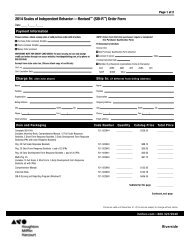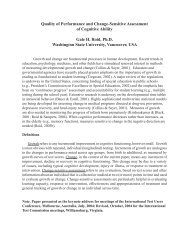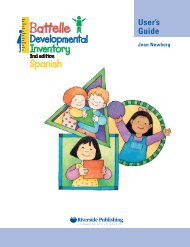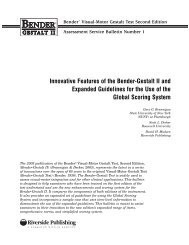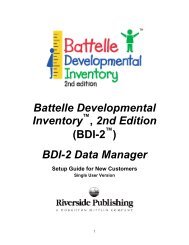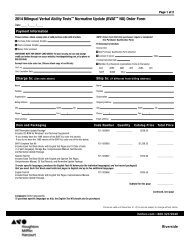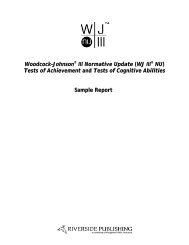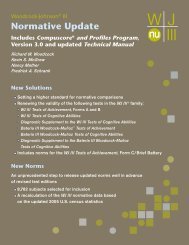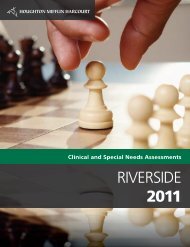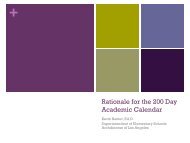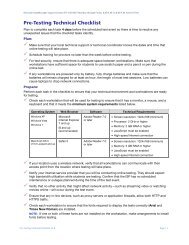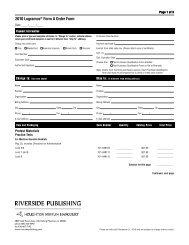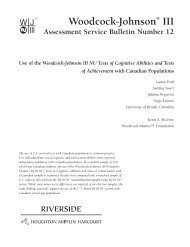Woodcock- Johnson III Tests of Cognitive Abilities - Riverside ...
Woodcock- Johnson III Tests of Cognitive Abilities - Riverside ...
Woodcock- Johnson III Tests of Cognitive Abilities - Riverside ...
Create successful ePaper yourself
Turn your PDF publications into a flip-book with our unique Google optimized e-Paper software.
the individual to compare new concepts to previously learned concepts or to useanalogies, metaphors, or similes when approaching a task (Greenleaf, 2005).Two additional Gf tests are included in the WJ <strong>III</strong> COG and DS. The NumberSeries test measures the ability to identify and apply an analog or rule to complete anumerical sequence. The mental representations (or “number sense”) that constitutethis ability form the basis for the ability to learn symbols for numbers and performsimple calculations (Dehaene, 1997, 2000). Number Matrices requires a foundation inmathematics knowledge (i.e., access to the category-specific verbal and visual codes,such as knowledge <strong>of</strong> the number line). However, in Number Matrices, the verbal and/orvisual codes are transcoded into analogical representations between sets <strong>of</strong> numbers.The solution to each item is obtained by mapping the relationship implied from the firstpart <strong>of</strong> the item onto the latter part <strong>of</strong> the item, thereby completing the analogy. Relatedinterventions involve explicit instruction in seriation and number reasoning skills (High/Scope Educational Research Foundation, 2003; Kroesbergen & Van Luit, 2003).Processing Speed (Gs )Efficiency <strong>of</strong> cognitive processing is based partly on the speed <strong>of</strong> mental activity. Formany years, cognitive speediness, or mental quickness, has been considered an importantaspect <strong>of</strong> intelligence (Nettelbeck, 1994; Vernon, 1983). “In the face <strong>of</strong> limited processingresources, the speed <strong>of</strong> processing is critical because it determines in part how rapidlylimited resources can be reallocated to other cognitive tasks” (Kail, 1991, p. 152).Processing Speed (Gs) is related to reading (Evans, et al., 2002), mathematics (Floyd, etal., 2003), and writing achievement (Floyd, et al., 2008; McGrew & Knopik, 1993).Two <strong>of</strong> the tests that compose the Gs cluster are Visual Matching and Decision Speed.Visual Matching is a perceptual speed measure, and Decision Speed measures speed<strong>of</strong> semantic processing (i.e., the speed <strong>of</strong> mental manipulation <strong>of</strong> stimulus content).Perceptual speed involves making comparisons based on rapid visual searches. Decisionspeed <strong>of</strong> semantic processing (i.e., the speed <strong>of</strong> mental manipulation <strong>of</strong> stimulus content)requires making symbolic comparisons <strong>of</strong> concepts. In contrast to decision making basedon physical comparisons, the semantic or acquired knowledge (rather than perceptualinformation) needed for the Decision Speed test influences the decision-making process.(Rapid Picture Naming and Pair Cancellation are also measures <strong>of</strong> processing speed.)There is some evidence that perceptual speed, as measured in Visual Matching orCross Out (another Gs test), is related to the orthographic processing required forreading. The rapid processing <strong>of</strong> visual symbols resembles the perceptual demands<strong>of</strong> reading. Research has confirmed the link between perceptual speed and reading(McGrew, 1993; McGrew, Flanagan, Keith, & Vanderwood, 1997).<strong>Cognitive</strong> speediness can sometimes be positively influenced by repetitive practice,speed drills, and use <strong>of</strong> computer games that require an individual to quickly makedecisions (Mahncke, Bronstone, & Merzenich, 2006; Tallal, et al., 1996). For example,repetition is an important factor in building speed. Repeated and extensive practicemay enable a student to perform the same tasks in a more automatic fashion to increasespeeded performance. Speed drills focus performance on quickly completing a task.When a student’s performance on familiar tasks is timed and progress monitored, speedmay increase. For example, the student might be asked to count aloud, or say the letters<strong>of</strong> the alphabet, as quickly as he or she can for 10 seconds. The number <strong>of</strong> numerals orletters named is recorded. The speed drill is repeated at regular intervals, recording thenumber <strong>of</strong> items named each time.10



